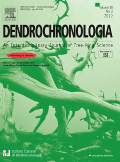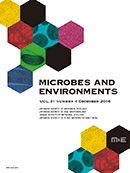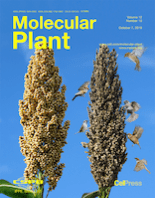
TREE PHYSIOLOGY
Scope & Guideline
Charting New Paths in Tree Physiology Studies
Introduction
Aims and Scopes
- Tree Physiology and Growth Dynamics:
Research on the physiological processes that influence tree growth, including studies on the factors affecting photosynthesis, respiration, and nutrient uptake. - Responses to Environmental Stress:
Investigation into how trees respond to various environmental stressors such as drought, salinity, and temperature changes, focusing on adaptive mechanisms and resilience. - Carbon and Nutrient Cycling:
Studies centered on the role of trees in carbon sequestration and nutrient cycling, including the dynamics of non-structural carbohydrates and their impact on tree health. - Tree-Microbe Interactions:
Exploration of the symbiotic and pathogenic relationships between trees and microorganisms, including mycorrhizal associations and responses to pathogens. - Evolutionary and Functional Ecology:
Research that examines the evolutionary adaptations of trees to their environments, including functional trait diversity and ecological implications.
Trending and Emerging
- Climate Change Adaptation:
Increasing emphasis on understanding how trees adapt to climate change, including studies on phenological shifts, drought tolerance, and responses to elevated CO2 levels. - Omics Approaches in Tree Biology:
The application of genomics, transcriptomics, and metabolomics is on the rise, providing deeper insights into the molecular mechanisms underlying tree physiology and stress responses. - Ecosystem Function and Services:
Research exploring the role of trees in ecosystem services, such as carbon sequestration, biodiversity support, and soil health, is gaining increased attention. - Interdisciplinary Research:
There is a trend towards interdisciplinary studies that combine insights from ecology, physiology, molecular biology, and environmental science to address complex questions in tree biology. - Microbiome Research:
Emerging interest in the role of the tree microbiome in health, growth, and stress resilience, highlighting the importance of microbial communities in tree physiology.
Declining or Waning
- Traditional Morphological Studies:
There has been a noticeable decrease in studies that focus solely on morphological characteristics of trees without integrating physiological or ecological perspectives. - Single-Factor Experimental Designs:
Research focusing on isolated variables, such as just drought or nutrient stress, is becoming less common as the field moves towards more integrative approaches that consider multiple interacting factors. - Basic Physiological Measurements:
The focus on fundamental physiological measurements (e.g., simple gas exchange metrics) is waning in favor of more complex analyses that incorporate molecular and genetic data.
Similar Journals

DENDROCHRONOLOGIA
Exploring the Interplay of Trees and ClimateDendrochronologia is a prestigious journal dedicated to the study of tree rings and their implications for understanding environmental changes, climate variability, and ecological dynamics. Published by Elsevier GmbH in Germany, it has consistently reached high academic standards, holding a remarkable Q1 ranking in both Ecology and Plant Science as of 2023, demonstrating its significant impact within these fields. The journal aims to foster interdisciplinary dialogue through the dissemination of original research, reviews, and methodological advancements related to dendrochronology, appealing to researchers, students, and professionals who seek to deepen their knowledge of the interactions between terrestrial ecosystems and climate change. Although it does not currently offer an open access option, Dendrochronologia remains an essential resource for those in the scientific community, with valuable insights that contribute to the understanding of biodiversity and ecological resilience.

JOURNAL OF PLANT RESEARCH
Pioneering Discoveries in Plant Science.JOURNAL OF PLANT RESEARCH, published by SPRINGER JAPAN KK, is a leading academic journal that has carved a niche in the field of Plant Science. With its ISSN 0918-9440 and E-ISSN 1618-0860, this journal has been disseminating high-quality research since its inception in 1993 and continues to be essential reading for academics and practitioners alike, aiming to bridge the gap between innovative plant research and practical applications. The journal is highly regarded, holding a prestigious Q1 ranking in Plant Science for 2023, and is positioned in the top 80th percentile within the Scopus rankings for Agricultural and Biological Sciences. The journal's coverage includes a wealth of topics pertinent to advancing our understanding of plant biology, ecology, and sustainable agricultural practices. Although it operates under a subscription model, its influence in the research community remains profound, making it a vital resource for contemporary studies in plant-related disciplines.

MICROBES AND ENVIRONMENTS
Connecting Microbial Insights to Environmental ImpactMICROBES AND ENVIRONMENTS is a prominent academic journal dedicated to advancing the field of microbial ecology, published by the Japanese Society of Microbial Ecology. Since its inception in 1996, the journal has provided a vital platform for disseminating innovative research and insights into the intricate relationships between microbes and their environments. With an impressive impact factor reflected in its Q2 rankings across multiple categories, including Ecology, Evolution, Behavior and Systematics, Medicine, Plant Science, and Soil Science, MICROBES AND ENVIRONMENTS is acknowledged as a significant contributor within the ecological and biological sciences community. The journal’s content, which spans over two decades of cutting-edge research, supports researchers, professionals, and students in enhancing their understanding of microbial functions and their critical roles in various ecosystems. The journal does not operate under an open access model, ensuring that submissions undergo a rigorous peer-review process that upholds its reputation for quality. Engage with MICROBES AND ENVIRONMENTS to explore the ever-evolving landscape of microbial research and its implications for environmental sustainability and public health.

TREES-STRUCTURE AND FUNCTION
Illuminating the vital role of trees in our ecosystem.TREES - STRUCTURE AND FUNCTION, published by Springer Heidelberg, is a leading journal dedicated to advancing the scientific understanding of tree biology through rigorous research and interdisciplinary approaches. With an impressive impact factor reflecting its high visibility in the scholarly community, this journal specializes in various aspects of tree ecology, physiology, and structure, making it a vital resource for researchers, professionals, and students engaged in forestry and environmental sciences. The journal holds notable rankings, placing it in the top quartiles of several categories, including Q1 in Forestry and Q2 in Ecology as of 2023, underscoring its relevance and influence in the field. Although it is not an open-access journal, TREES strives to disseminate critically important findings that contribute to our understanding of global forest ecosystems and their role in climate change mitigation. With a publication history spanning from 1986 to 2024, this journal continues to shape the future of tree research, providing a platform for innovative studies that inform policy, conservation, and sustainable practices.

Molecular Plant
Elevating the discourse in molecular plant research.Molecular Plant, published by CELL PRESS, is a premier journal dedicated to advancing the field of molecular biology and plant science. With an impressive impact factor reflecting its rigorous peer-review process and the high quality of its published research, this journal has achieved a remarkable Q1 ranking in both Molecular Biology and Plant Science categories as of 2023. Its Scopus rankings place it within the top echelons of its field, holding 2nd place in Agricultural and Biological Sciences - Plant Science, showcasing its vital role in disseminating impactful research. The journal covers a broad range of topics, including but not limited to, plant genetics, molecular interactions, and biotechnological advances. Research published in Molecular Plant has the potential to significantly influence agricultural practices and biotechnological applications, making it an essential resource for researchers, professionals, and students eager to stay at the forefront of plant research. Access options for the journal are tailored to accommodate a wide audience, facilitating engagement with cutting-edge findings and breakthroughs. As the field of plant science continues to evolve, Molecular Plant remains integral to fostering innovation and collaboration within the scientific community.

Icelandic Agricultural Sciences
Bridging Research and Practice in Crop ScienceIcelandic Agricultural Sciences, published by RANNSOKNASTOFNUN LANDBUNADARINS, serves as a vital platform for the dissemination of research in the field of Agronomy and Crop Science. Established to contribute to the advancement of agricultural knowledge in Iceland and beyond, this journal aims to foster collaboration among researchers, professionals, and students dedicated to sustainable agricultural practices. Despite facing a Q4 category ranking in 2023 and a ranking of #344/406 in Scopus, the journal continues to attract diverse research contributions, especially focusing on unique challenges and innovations pertinent to Icelandic agriculture. The journal operates under a traditional access model, providing an essential resource for those looking to deepen their understanding of agronomic developments and their implications for the agricultural sector. With a commitment to increasing awareness and promoting scientific dialogues, Icelandic Agricultural Sciences plays a crucial role in nurturing the field's growth and enhancing agricultural research.

IAWA JOURNAL
Shaping the Future of Forestry ResearchIAWA JOURNAL is a distinguished academic publication dedicated to the fields of forestry and plant science, published by BRILL, a reputable name in scholarly publishing. With an ISSN of 0928-1541 and an E-ISSN of 2294-1932, the journal has garnered impressive rankings within Scopus, placing 48th in Forestry and 182nd in Plant Science, indicating its strong influence and relevance in these scientific areas. Operating from the Netherlands, the IAWA JOURNAL focuses on a broad scope of research themes, contributing to the advancement of knowledge from its inception in 1980 and continuing robustly through to 2024. With a Category Quartile of Q2 in Forestry and Q3 in Plant Science as of 2023, the journal serves as a vital resource for researchers, professionals, and students alike, facilitating the exchange of innovative ideas and significant findings in the plant biology community. Although the journal does not currently offer open access, it remains a pivotal platform for disseminating high-quality research that shapes the future of the ecological and environmental sciences.

Forest Ecosystems
Connecting research to conservation efforts.Forest Ecosystems is a prestigious open access journal published by KEAI PUBLISHING LTD, dedicated to advancing knowledge in the fields of forestry, ecology, and conservation. Established in 2014 and located in Beijing, China, this journal has rapidly gained prominence, achieving Q1 status in multiple categories, including Ecology, Evolution, Behavior and Systematics, and Forestry in 2023. With an impressive rank of 19 out of 174 in the Scopus category of Agricultural and Biological Sciences - Forestry, it stands in the 89th percentile, reflecting its influential contributions to the field. The journal fosters scholarly discourse and disseminates innovative research aimed at understanding forest ecosystems and their vital role in our environment. Offering a robust platform for researchers, professionals, and students, Forest Ecosystems ensures accessibility through its open access format, enabling a wider audience to engage with and benefit from cutting-edge research dedicated to the stewardship of forest resources.

Tree Genetics & Genomes
Elevating tree genetics research for global impact.Tree Genetics & Genomes is a premier academic journal published by Springer Heidelberg, dedicated to advancing the field of tree genetics and genomics. Since its inception in 2005, this journal has played a crucial role in disseminating high-quality research that addresses critical questions in tree biology, horticulture, and forestry. The journal is highly regarded within the academic community, as evidenced by its impressive Q1 rankings in both Forestry and Horticulture categories for 2023 and a substantial presence in key genetic research areas. Furthermore, its Scopus rankings affirm its influence across disciplines, ranking among the top journals in Agricultural and Biological Sciences. Although currently not an open-access publication, it aims to provide authors and readers with a platform to share innovative findings and insights that shape sustainable practices in tree planting and management. With a commitment to fostering knowledge in the genetic and genomic analysis of trees, Tree Genetics & Genomes is an essential resource for researchers, professionals, and students alike, contributing to the global understanding of tree biology and its environmental significance.

Physiological Genomics
Pioneering Research at the Intersection of Genes and PhysiologyPhysiological Genomics is a prestigious scholarly journal published by the American Physiological Society, dedicated to advancing the understanding of the genetic underpinnings in physiology. With an ISSN of 1094-8341 and an E-ISSN of 1531-2267, this journal serves as a vital platform for researchers exploring the intersection of genetics and physiological processes. As of 2023, it enjoys a respectable impact factor, particularly standing strong in the Q2 quartile in both Genetics and Physiology categories, illustrating its importance within a competitive landscape. With an impressive rank of #69 out of 193 in Biochemistry, Genetics, and Molecular Biology - Physiology, and #128 out of 347 in Genetics, it reflects a robust commitment to quality research. Committed to fostering innovation, Physiological Genomics provides comprehensive access to groundbreaking studies from 1999 to 2024 and remains a quintessential resource for researchers, professionals, and students alike aiming to enhance their understanding of physiological genomics.